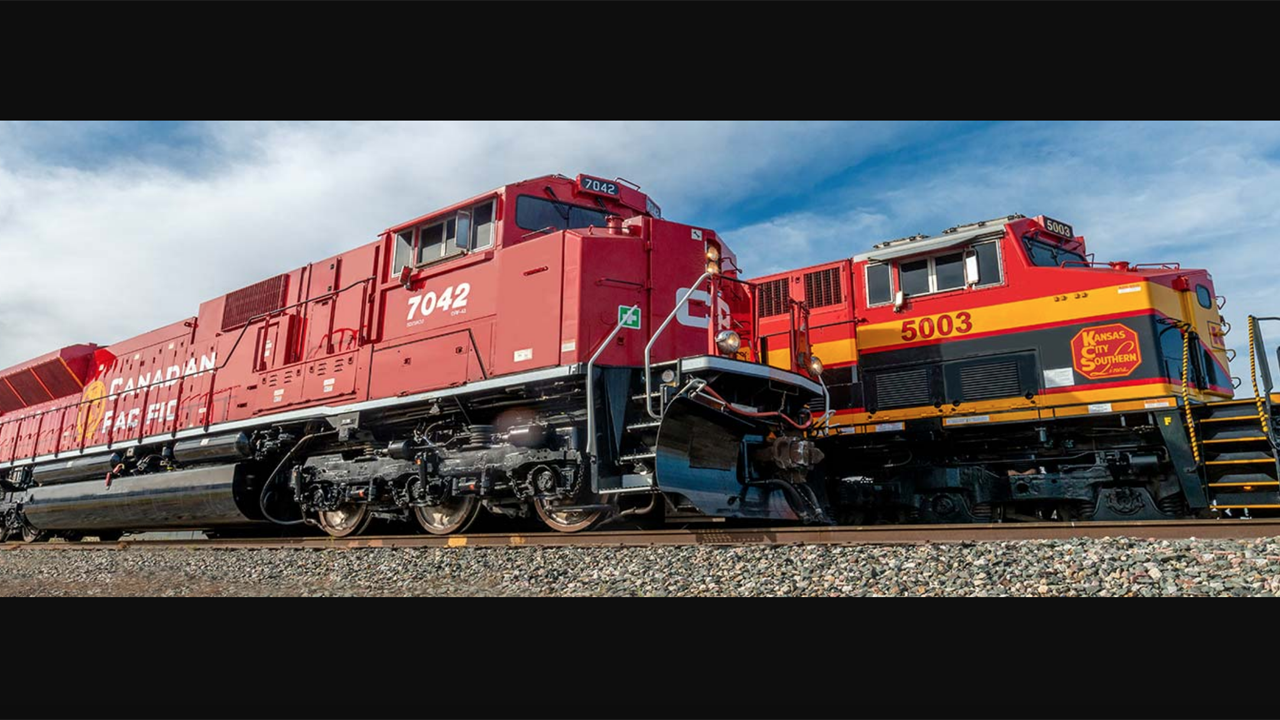
STB to CP-KCS: Clarify Data From Proposed Merger Filings
Written by Marybeth Luczak, Executive Editor
The Surface Transportation Board (STB) on March 16 asked merger partners Canadian Pacific (CP) and Kansas City Southern (KCS) to address an apparent “inconsistency in the calculation of traffic density numbers” that were submitted to the STB and to the STB’s Office of Environmental Analysis regarding their proposed combination.
CP and KCS in September 2021 agreed to combine and form Canadian Pacific Kansas City (CPKC), the first U.S.-Mexico-Canada rail network. STB in November 2021 accepted for consideration their application, and as part of the review process, the Office of Environmental Analysis is assessing CPKC’s potential effects on the environment.
The STB explained in its March 16 decision (download below) that CP and KCS “submitted traffic density charts in Exhibit 14 as required by 49 C.F.R. § 1180.8(a)(5). … Exhibit 14 shows CP and KCS lines that handle one million or more gross ton-miles per mile of road (GT/M) per year and respective densities, broken down by segments of such lines between major freight yards and terminals. Applicants’ Exhibit 14 contains 2019 baseline and 2020 GT/M data for CP and KCS lines, as well as estimated GT/M levels upon full integration of the CP-KCS networks that would be expected to occur three years following Board approval of the Transaction. …
“On October 28, 2021, one day before filing the [merger] Application, Canadian Pacific responded to an information request from the Board’s Office of Environmental Analysis (OEA), submitting requested materials that were developed in cooperation with KCS. … CP’s submission includes a ‘Master Segment Table,’ which contains, among other things, 2019 baseline GT/M data for CP and KCS lines. … However, it appears that the 2019 baseline GT/M data in the Master Segment Table submitted to OEA are different from the 2019 baseline GT/M data in Exhibit 14 of the Application.”
CP and KCS now must “address the apparent inconsistency and indicate which of the two baseline data sets submitted should be used in analyzing the environmental and transportation impacts of the transaction, and the reasons why that data should be used,” according to STB. This information is due by March 21, 2022; replies are due no later than five days following the railroads’ submission. STB reported that it has suspended the procedural schedule in the merger proceeding until further order.
CP issued the following statement in response to the STB decision:
“CP welcomes and expects a comprehensive regulatory and environmental review of our application and shares the STB’s desire for accurate, consistent information across all aspects of that review. As called for by the decision, CP will submit to the STB by March 21 a full explanation of the data submitted with its Application and shared with the Board’s Office of Environmental Analysis in connection with its review of the Application. We look forward to the STB restarting the procedural schedule for its review of the proposed CP-KCS transaction following its review of the explanation Applicants will provide.”
STB Procedural Schedule for CP-KCS Merger Proposal Review:
October 29, 2021: Application filed.
November 26, 2021: Board notice of acceptance of Application to be published in the Federal Register.
December 13, 2021: Notices of intent to participate in this proceeding due.
December 28, 2021: Proposed Safety Integration Plan (SIP) to be filed with STB’s Office of Environmental Analysis (OEA) and the Federal Railroad Administration (FRA).
January 12, 2022: Descriptions of anticipated responsive, including inconsistent, applications due. Petitions for waiver or clarification with respect to such applications due.
February 22, 2022: Responsive environmental information and environmental verified statements for responsive, including inconsistent, applicants due.
February 28, 2022: Comments, protests, requests for conditions, and any other evidence and argument in opposition to the Application due. This includes any comments from the U.S. Department of Justice (DOJ) and U.S. Department of Transportation (USDOT). Responsive, including inconsistent, applications due. (CN, Union Pacific and BNSF are among those that submitted responsive applications.)
March 30, 2022: Notice of acceptance of responsive, including inconsistent, applications, if any, published in the Federal Register.
April 22, 2022: Responses to comments, protests, requests for conditions, and other opposition due, including to DOJ and USDOT filings. Rebuttal in support of the Application due. Responses to responsive, including inconsistent, applications due.
May 23, 2022: Rebuttals in support of responsive, including inconsistent, applications due.
July 1, 2022: Final briefs due. (Note: “The Board will also determine the page limits for final briefs in a later decision after the record has been more fully developed.”)
TBD: Public hearing (if necessary). (Note: “The Board will decide whether to conduct a public hearing in a later decision after the record has been more fully developed.”)
TBD: Service date of final decision. (Note: “49 U.S.C. § 11325(b)(3) provides that the Board must issue its final decision within 90 days of the close of the evidentiary record and that evidentiary proceedings be completed within one year of the date of publication of this notice in the Federal Register. However, under NEPA, the Board may not issue a final decision until after the required environmental review is complete. In the event the EIS process is not able to be concluded in sufficient time for the Board to meet the 90-day provision set forth in § 11325(b)(3), the Board will issue a final decision as soon as possible after that process is complete.”)



